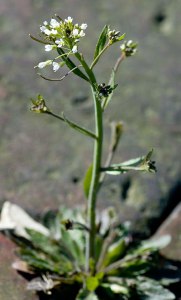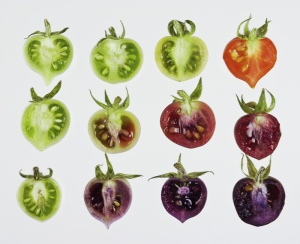The tomato, a relative of the potato, is one of the most popular fruits. Their famous red colour is due to anthocyanins, a group of water-soluble pigments, belonging to the class of flavonoids. Fruits containing these compounds often appear as red, blue or purple. Anthocyanins have antioxidant properties, often deactivating and removing free radicals – highly reactive molecules due to unpaired electrons, that have the potential to cause cellular damage. Therefore, anthocyanins are seen to help minimise damage to cells and their signalling pathways, and reduce inflammation. Because of their ‘superfood’ status, they have been the focus of many scientific studies.
Genetic modification has been used on some crops to enhance and increase levels of antioxidants in fruits, as a way of bringing new health benefits to the consumer. A really good example of how GM was successful can be seen with the case of the purple tomatoes. They were developed by Prof Cathie Martin and her colleagues at the John Innes Centre. Their main focus was to breed tomatoes with a higher level of anthocyanins, using a GM technique. Two genes were identified from two different plant species, and inserted into the DNA of the tomato plant. One gene was taken from Arabidopsis thaliana (a common weed used as a model for many plant experiments), and the gene was shown to be responsible for the activation of flavonoid biosynthesis. The other gene identified came from a common garden flower, the snapdragon, and it is responsible for the production of anthocyanins in the colourful flowers.
The lab was successful in producing three sets of tomatoes. Insertion of the Arabidopsis or snapdragon gene produced tomatoes that were purple or orange, respectively. These tomatoes were compared to the wild type red tomatoes. Also, further experimentation of using all three genes simultaneously resulted in tomatoes with dark indigo fruit.
The result was that the purple and indigo tomatoes did indeed have a substantially higher proportion of anthocyanins than the naturally red tomatoes. This also meant a significant increase in levels of antioxidants. They then tested the health benefits of these tomatoes further, by supplementing them into the diets of cancer-prone mice. As a result, their lifespans were significantly extended. Of course, mice are not quite the same as humans, so it would be necessary to conduct clinical studies with human participants. However, because of Europe’s overall negative attitude towards GM, Prof Martin took her research to Canada, with the aim of developing food products containing purple tomato juice. Across the seas, clinical trials with purple tomato juice are now in the pipeline.
You might be wondering why the need for GM when naturally purple-skinned tomatoes do exist. But in actual fact, these purple tomatoes don’t have the same levels of anthocyanins compared to the GM purple tomatoes. GM purple tomatoes have anthocyanins present throughout the skin and flesh unlike their traditionally bred counterparts. Not only that, higher levels of anthocyanins have been proven to double the shelf life of tomatoes. Studies show that anthocyanins help delay over-ripening of the fruits, therefore reducing the risk of infection by fruit molds. Surely a benefit to the food industry?
All in all, I think an important point should be made from all of this. If we are to help global populations fight against hunger, malnourishment and disease, we need to stop looking at how a food product is made and instead focus on the health benefits that it can provide.
Maybe it’s time to give purple tomatoes a go.





